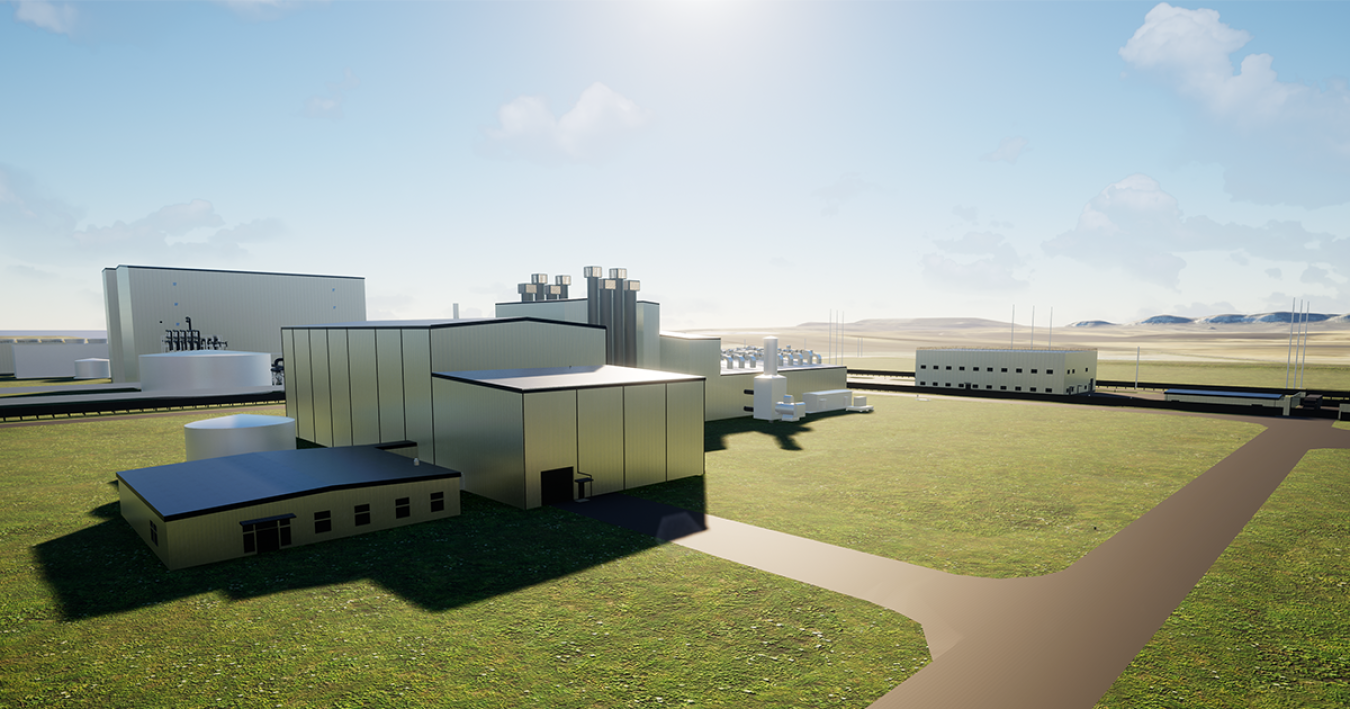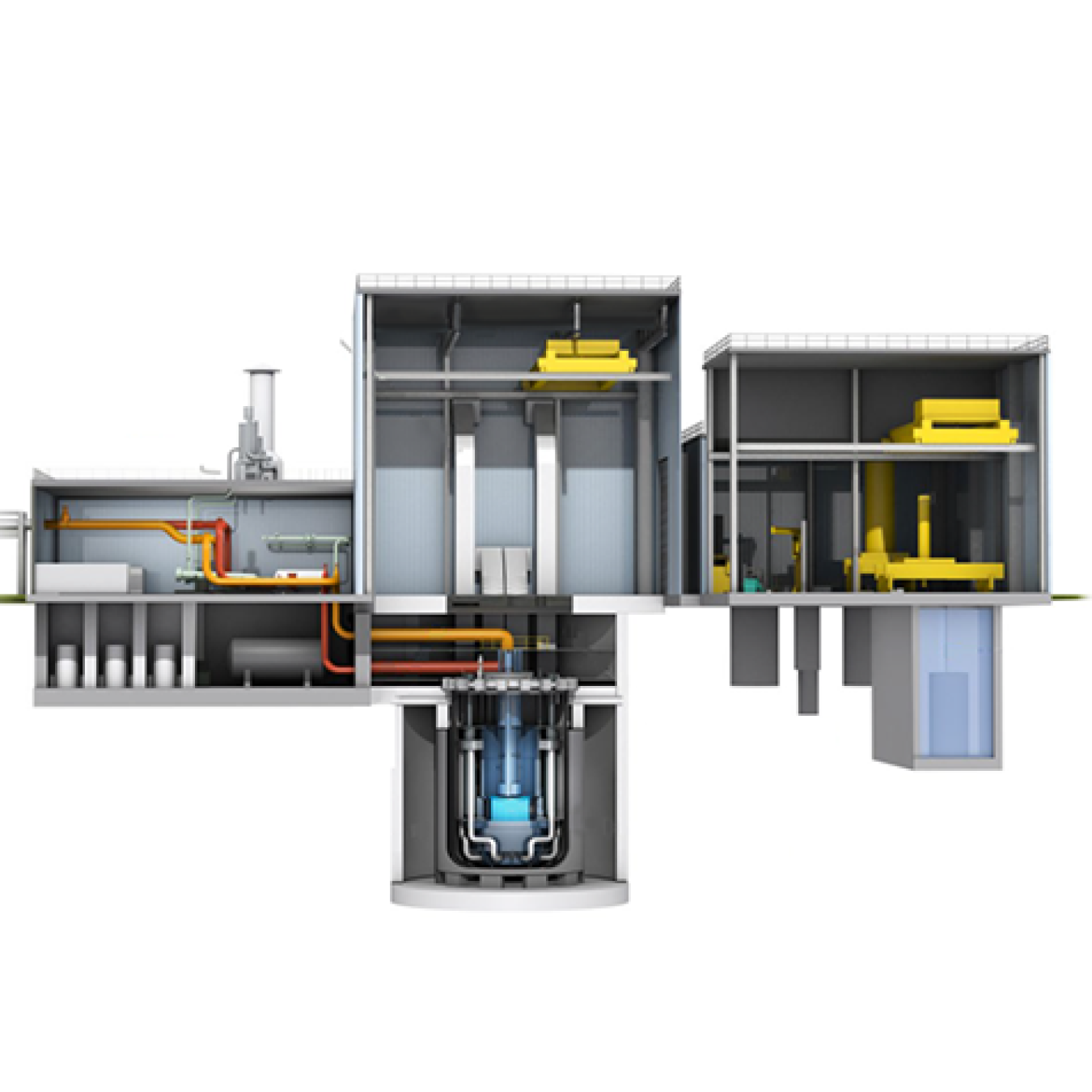TerraPower's decision to build its advanced reactor in Wyoming expected to create jobs and clean energy opportunities for the state.
November 16, 2021
Rendering of TerraPower’s Natrium power plant.
Updated 11/2/2023
TerraPower announced plans to build its Natrium reactor near a retiring coal plant in Kemmerer, Wyoming. This is an incredible opportunity for the state, which currently generates more than 81% of its electricity generation from fossil fuels. The Natrium design represents the future of advanced nuclear reactor technology and is well-suited to provide clean and efficient power to communities across the United States, including the Mountain West.
The U.S. Department of Energy is extremely excited about this project and plans to invest nearly $2 billion to support the licensing, construction and demonstration of this first-of-a-kind reactor.
The Natrium project will create thousands of construction jobs and hundreds of permanent jobs once the plant is online. It will not only leverage the existing energy infrastructure already in place at the coal plant but also the local power plant workforce who can work with utilities to transition or apply their skills to higher paying jobs in nuclear energy.
The New Look of Nuclear

Natrium Reactor Demonstration Project.
TerraPower leads one of two teams awarded initial funding through our Advanced Reactor Demonstration Program to test, license and build the next generation of American advanced reactors. The Natrium reactor offers significant improvements over today’s nuclear power plants and will help set the tone for a new portfolio of U.S. advanced reactors that are under development to ultimately compete in the U.S. and global markets.
Natrium is a sodium-cooled fast reactor that is paired with a molten salt energy storage system to flexibly operate with renewable power sources. Its simplified design and use of advanced construction methods will make it faster and more affordable to build, and its constant high operating temperature can be used to generate carbon-free heat or electricity to drive other energy-intensive manufacturing processes.
Natrium will be the first commercial reactor ever in the state of Wyoming and one of the first advanced reactors to operate in the United States, expanding the state’s already impressive energy portfolio.
Bringing Jobs Back to Wyoming
Wyoming is an energy-rich state and our nation’s largest producer of coal, natural gas and crude oil. Roughly 70% of its electricity production comes from coal-fired power plants that have been steadily declining since the mid-2000s.
The state’s largest utility, PacifiCorp, plans to reduce its coal fleet down to two power plants by 2030. These closures will directly impact the communities built around the plants—losing millions in state and local tax revenue that help pay for public schools and infrastructure projects.
By demonstrating the Natrium reactor near the retiring Naughton coal plant, TerraPower can not only take advantage of the existing energy infrastructure that is in place (such as cooling water intakes and electrical distribution), but also the workforce. This project leverages innovations from the concentrated solar power, tunneling, and combined cycle gas turbine industries. It also intends to utilize the latest advanced construction and manufacturing methods to bring thousands of jobs back to the area.
Hundreds of workers will be needed to fabricate complex parts and components, thousands of skilled construction workers will be required to build the nuclear and energy islands, and hundreds of plant operators, maintenance crews, and security staff will be needed full-time to operate one of the most-advanced nuclear reactor systems in the world.
Natrium’s thermal energy storage system also provides opportunities for new markets to evolve in the region. The high-temperature heat or electricity generated by the reactor can be used to produce hydrogen to create carbon-free synthetic fuels or decarbonize the oil refining process. It can also be directed to power local mining operations in the area to help lower emissions in the extraction of coal, natural gas, and uranium fuel.
Gaining Access to Nuclear
The Biden-Harris Administration believes no community should be left behind. This investment through the bipartisan Infrastructure Investment and Jobs Act will not only bring back jobs to the area, but cleaner air and improved health for the community.
Once operating, the Natrium plant is estimated to produce nearly 3 million megawatt hours of carbon-free power each year and avoid almost 2 million metric tons of carbon. It will also avoid other pollutants that lead to smog and acid rain to improve the overall air quality in the region.
The Western United States currently has three nuclear power plants in operation. By siting this advanced reactor in Wyoming, TerraPower is also expanding access to communities in the state and the Mountain West that have not had the opportunity to benefit from clean and reliable nuclear power.
Along with Natrium, another advanced reactor is expected to operate in the Northwest region. NuScale plans to operate its first advanced small modular light water reactor system at Idaho National Laboratory—making this region the new hub of nuclear innovation.
What’s Next?
TerraPower is currently working on a construction permit application for submittal to the U.S. Nuclear Regulatory Commission (NRC), which it hopes to submit in 2024. The team will also further develop its plant design and initiate long-lead procurements.
Alice Caponiti

Alice Caponiti serves as the Deputy Assistant Secretary for Strategic Crosscuts in the Office of Nuclear Energy. She leads a diverse portfolio of research, development and demonstration programs focused on the technical and economic sustainability of the existing U.S. fleet of commercial reactors and the development and deployment of innovative advanced reactors, including small modular reactors and microreactors. Ms. Caponiti is managing a new cost-shared program with industry to demonstrate multiple advanced reactor designs that offer improved safety, functionality and affordability, leading to expanded market opportunities for clean energy. Her office also sustains the nuclear talent pipeline through competitive university R&D and infrastructure investment programs. Ms. Caponiti serves as chair of the Generation IV International Forum Policy Group that advises on research and development needed to establish the feasibility and performance capabilities of the next-generation nuclear energy systems.
Ms. Caponiti previously led efforts to design, build, test, and deliver safe and reliable nuclear power systems for space exploration and national security applications and conduct detailed safety analyses for each mission. She served as the technical advisor to the Department of State and a United Nations working group on space nuclear power sources, as well as a risk communications spokesperson for the New Horizons mission to Pluto and the Mars Science Laboratory mission that delivered the Curiosity rover to the surface of Mars. Prior to joining the Office of Nuclear Energy in 2001, she worked on a nonproliferation program to reduce stockpiles of excess Russian weapons plutonium.
Ms. Caponiti has a bachelor’s degree in civil engineering from the University of Maryland and master degrees in nuclear engineering and the Technology and Policy Program from the Massachusetts Institute of Technology.
[email protected]
301-903-6062 (office)
240-751-6774 (mobile)

